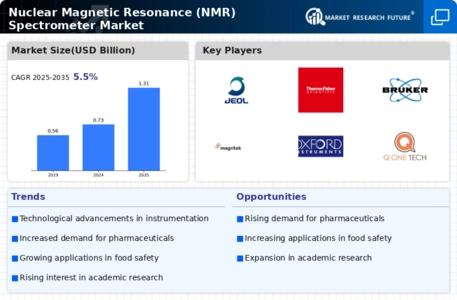Leading market players are investing heavily in research and development in order to expand their product lines, which will help the nuclear magnetic resonance (NMR) spectrometer market, grow even more. Market participants are also undertaking a variety of strategic activities to expand their footprint, with important market developments including new product launches, contractual agreements, mergers and acquisitions, higher investments, and collaboration with other organizations. To expand and survive in a more competitive and rising market climate, Nuclear magnetic resonance nmr spectrometer industry must offer cost-effective items.
Manufacturing locally to minimize operational costs is one of the key business tactics used by manufacturers in the nuclear magnetic resonance (NMR) spectrometer industry to benefit clients and increase the market sector. In recent years, the nuclear magnetic resonance (NMR) spectrometer industry has offered some of the most significant advantages to medicine. Major players in the Nuclear magnetic resonance nmr spectrometer market, including JEOL Ltd., Thermo Fisher Scientific Inc., Bruker, Magritek, Oxford Instruments, Nanalysis Corp., Anasazi Instruments, Inc., QOneTec, Advanced Magnetic Resonance Limited and others, are attempting to increase market demand by investing in research and development operations.
JEOL Ltd (JEOL) is a supplier of instruments and equipment for electron optics. The business produces, markets, develops, and conducts research on scientific and metrology instruments, semiconductor equipment, industrial equipment, and medical equipment for high-quality scientific and industrial research and development. In addition, it buys and sells peripherals in addition to processing, maintaining, and offering services for related goods and components. The firm offers these services to many different industries, including those in the fields of aerospace, automotive, agriculture, biotechnology, chemicals, medical, metals and mining, energy, pharmaceuticals, semiconductors, electronics, environment, and forensics.
The Americas, Europe, Asia, and Australasia are the regions where Joel sells its products. The headquarters of JEOL are located close to Akishima in Tokyo, Japan.
Thermo Fisher Scientific Inc. (Thermo Fisher) delivers medical equipment, analytical instruments, reagents and consumables, software, and services to satisfy the demands of challenging analytical challenges in research, diagnostics, and clinical laboratories. It offers solutions for cellular biology, synthetic biology, and flow cytometry. Mass spectrometry, genetic sequencing, electron microscopy, protein, and molecular biology research equipment are just a few of the many products that the company sells.
The company offers services to companies in the environmental, industrial quality, and process control sectors, as well as to academic and research institutes, governmental organizations, pharmaceutical and biotech companies, clinical diagnostic laboratories, and environmental companies. It provides its products and services through its direct sales force, online sales, and third-party distributors across the Americas, Asia-Pacific, and Europe. The headquarters of Thermo Fisher are located in Waltham, Massachusetts, in the US.


















Leave a Comment